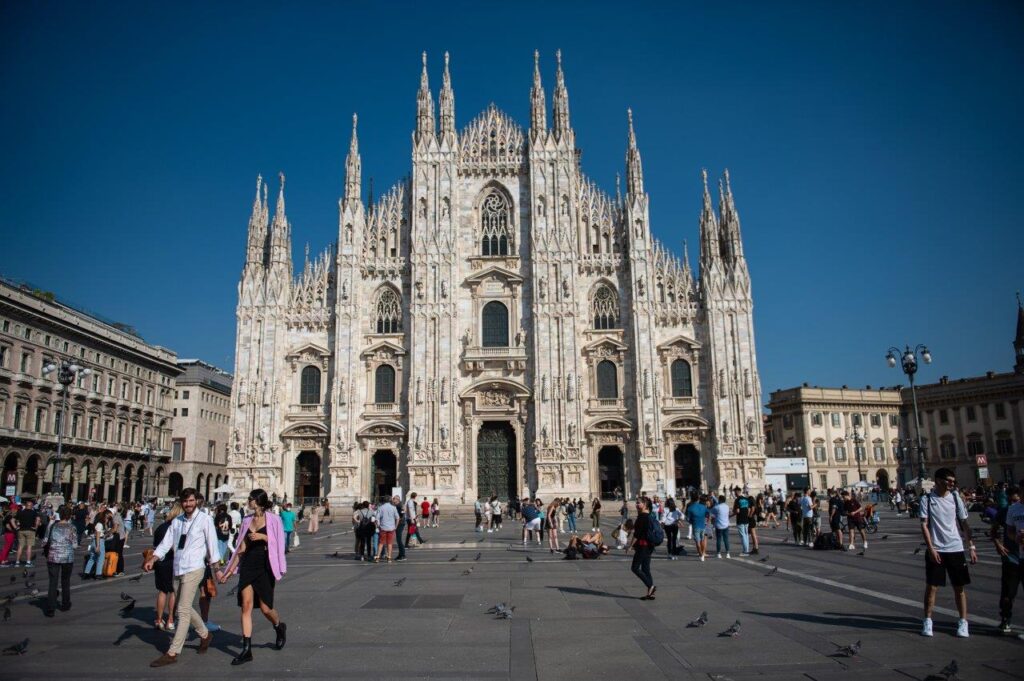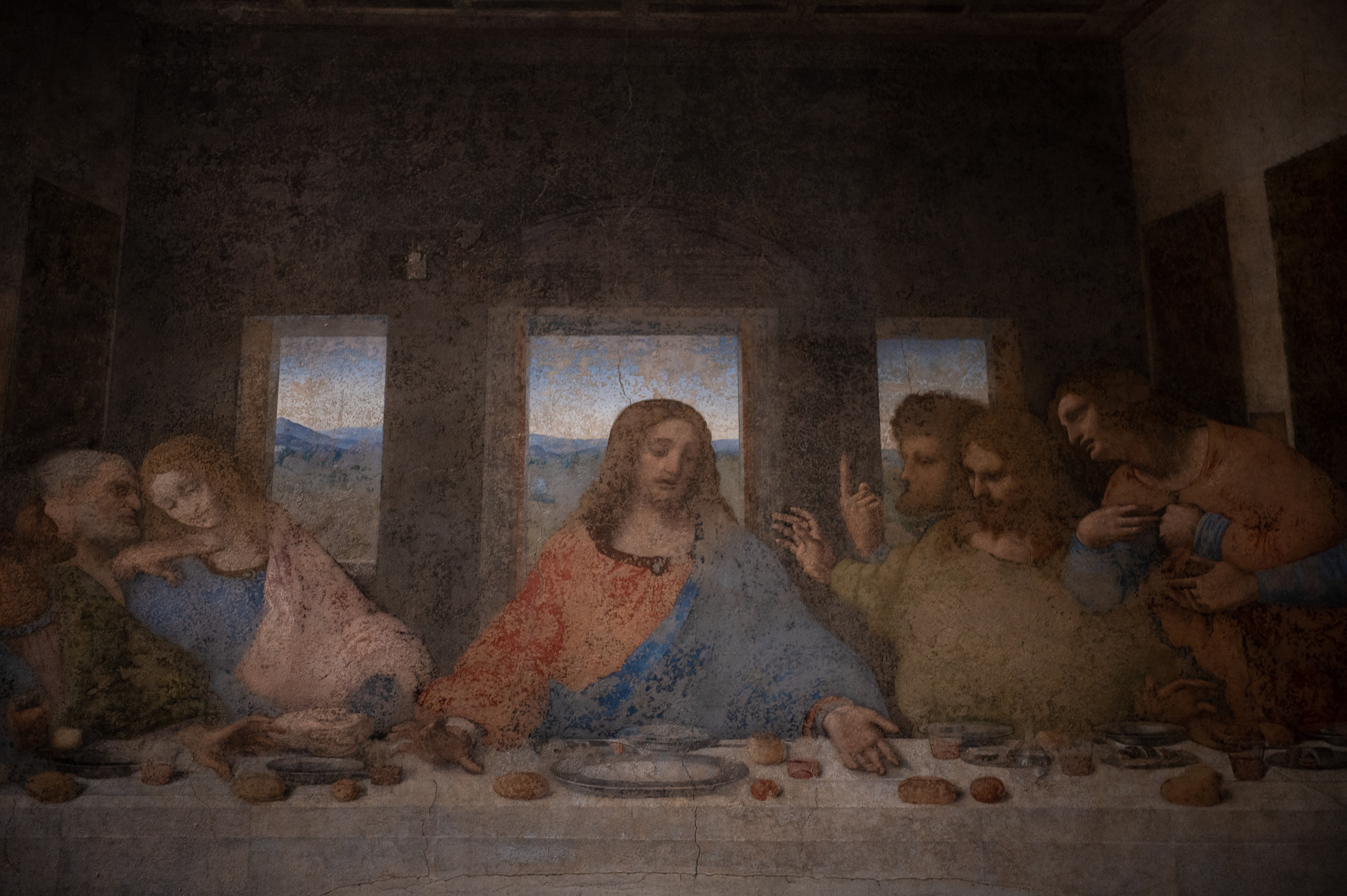THE LAST AND THE FIRST SUPPER
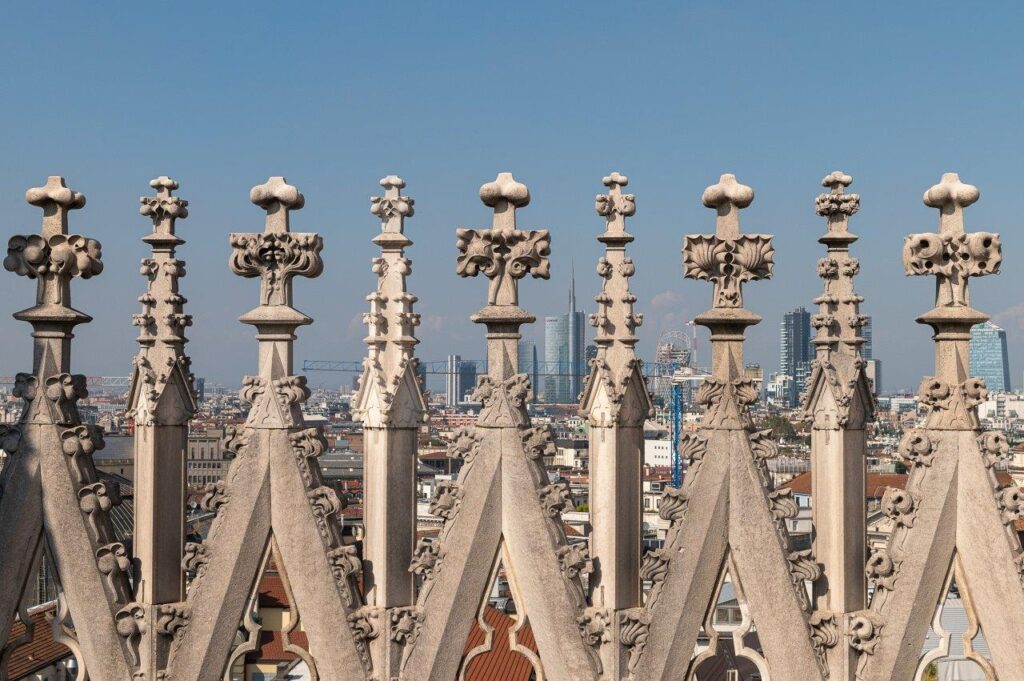
PART ONE: THE LAST SUPPER
At 33, the age Jesus died on the cross, Leonardo da Vinci started to work on a fresco in the refectory, the dining hall, of the Dominican convent Santa Maria delle Grazie in Milan: Il Cenacolo – The Last Supper – was commissioned by Ludovico Sforza, the Duke of Milan, who wanted to turn the chapel’s choir into a family mausoleum and was still searching for an appropriate interior design.
Ludovico, a short, chubby man dubbed Il Moro for his dark complexion, was also 33. He had come to power a few years before, after the mysterious death of his elder brother, the actual heir to the throne after their father’s assassination. Since Ludovico himself had recently been victim of an unsuccessful assassination attempt as well, he found it appropriate to quote Mathew 6:21 underneath the fresco in golden letters:
Amen dico vobis quia unus vestrum me traditorus est – Truly I tell you that one of you will betray me.
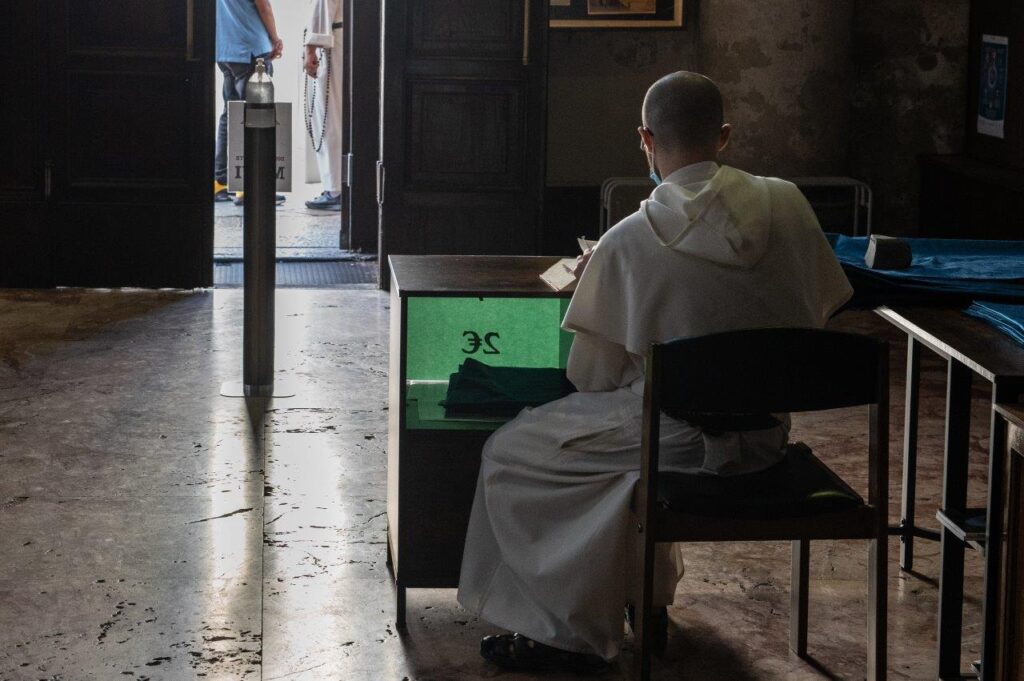
Technically, Il Cenacolo was a failure. Leonardo had invented a new way of fresco painting, since the current technique, which required the appliance of colour on still wet plaster, didn’t correspond to his temperament and mood swings. Instead he came up with a method that allowed him to apply tempura on dry plaster, to the effect that in the damp, dark refectory the paint started peeling before the fresco was even finished a couple of years later.
Yet, the Last Supper is one of the most venerated works of art in Western civilization. A present day visitor to the still dark and damp, but now meticulously monitored and air-conditioned refectory in the center of Milan will see not only Leonardo’s work, but 500 years of skilful art restoration. This fact only adds to Il Cenacolo’s attraction. The fresco does not only tell the story of how Jesus got betrayed by one of his own disciples, but of how one single person’s strike of genius was granted eternal life by the common effort of the many.
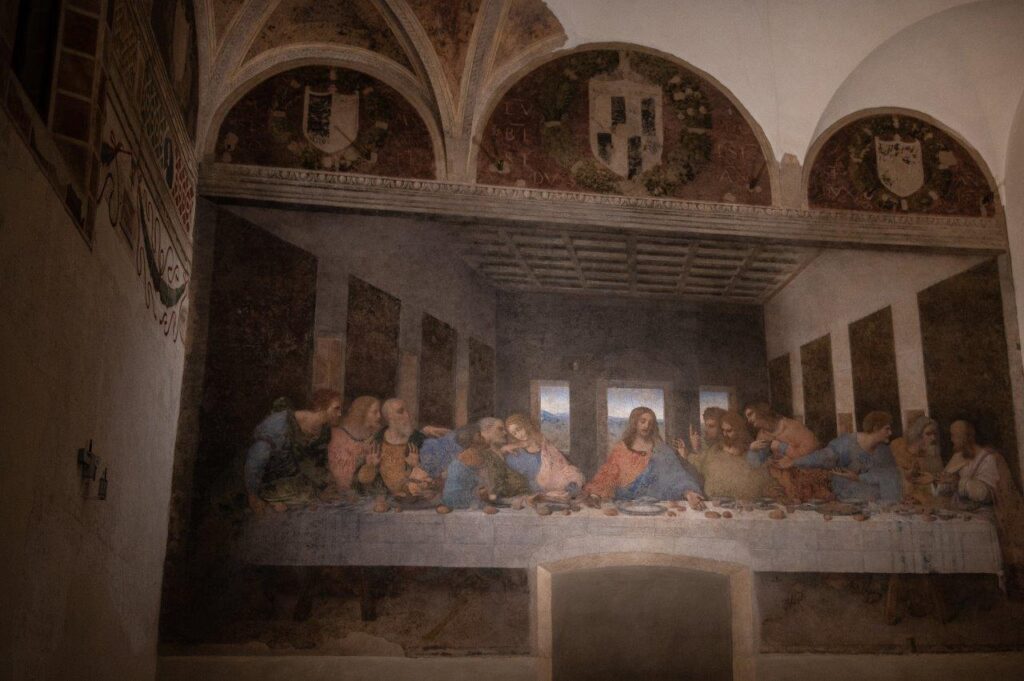
The Tuscan inventor Da Vinci had moved to Milan only recently. The proverbial Renaissance man, self-trained in all natural sciences as well as music and art, had found the atmosphere at the court of Florence too stifling. Since Leonardo didn’t speak Latin, the language of science and contemporary erudition, he remained an outsider of scholarly circles, working as a stage designer and producer of pageants at the Medici court.
Despite his love for interdisciplinary thinking, Leonardo appeared a rather undisciplined man. Extravagantly dressed, gay and vegetarian, indulging in numerous love affairs, he liked to go with the flow, unrestrained, get lost in thoughts or on his extended ambles through nature. When the glamour couple, Ludovico Il Moro and his teenage wife Beatrice d’Este, summoned scholars and artists from all over the peninsula to their court in Milan, Leonardo followed their call and applied as military engineer.
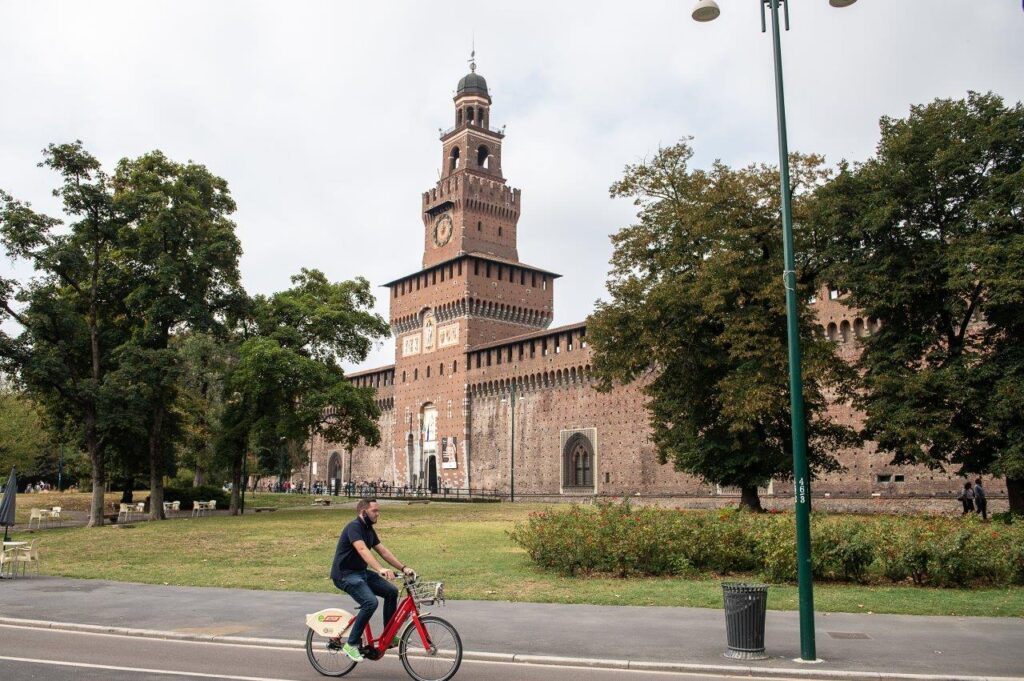
The Sforza family were a military dynasty in permanent struggle with Venice in the East and France in the West. With the introduction of rice to the foggy marshlands of the Po valley, as well as with the gains of the silk industry, exploiting the local abundance of mulberry trees and their worms, Ludovico’s father had amassed incredible riches, making Lombardy and its capital Milan the wealthiest state of the Renaissance. The Sforza court was the most splendid court in Europe. The Milanese societies enjoyed intellectual diversity and freedom that came with the arrival of artists and scholars from all over the peninsula. Still searching to legitimate the Sforzas hegemony by means of a veritable marketing campaign, Ludovico Il Moro had called them scholars to flock to Milan, and compose his peans, create his statues, and construct his buildings to eternalize his fame.
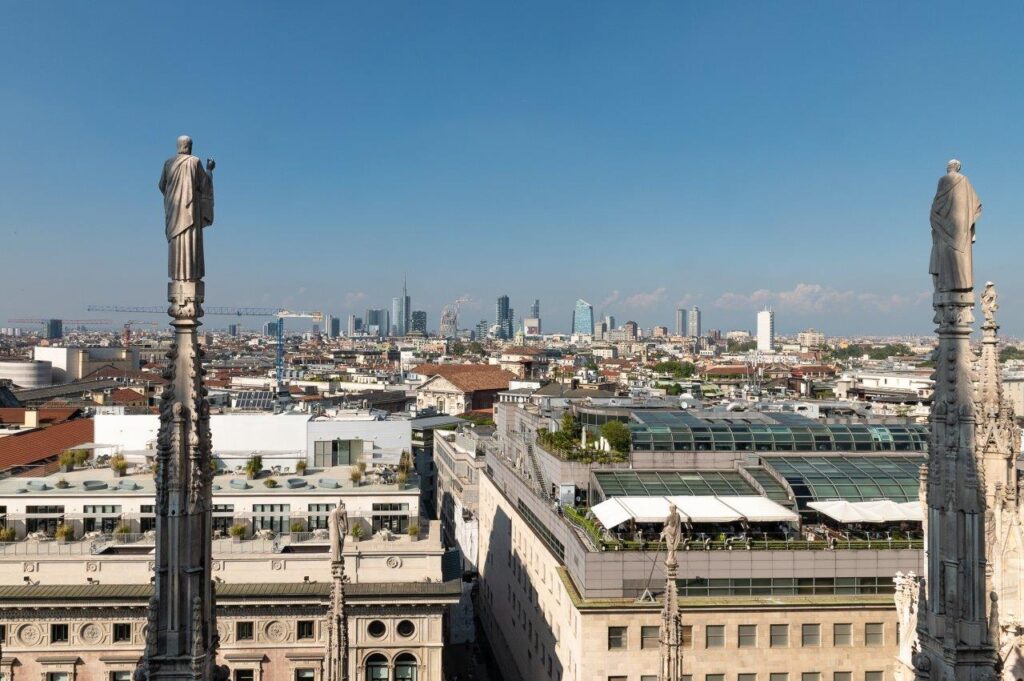
When Leonardo arrived in the big city, Milan counted 125,000 inhabitants, three times the size of Rome or Florence. Despite the riches of the court, the poor, crowded quarters of Milan were frequently stricken by the bubonic plague. It was in fact under the reign of the Sforza dynasty, that the first lockdown to confine a contagious desease was ever implemented: A Magistrato di Sanità had been installed and government clerks registered the dead, quarantined the ill and their households, and issued green passes to the healthy. Sewage and waste were controlled in public spaces, non-essential trades closed down and infected houses purged.
Immediately upon arrival, Leonardo set out to design the ideal city in times of the Plague. He envisioned broad streets that prevented the spreading of germs, lined with trees and flowers, relegating everything that wasn’t pleasing to the eye to an underground system of canals. Of course, none of his architectural plans were every realised, as weren’t any other of the inventions he sent to Ludovico Il Moro in his letter of application: portable bridges and cannons of beautiful design, unassailable war vehicles, wonderful catapults and sea crafts that would resist all fire and powder and smoke. Having intensely studied perspective and proportion on his own, Leonardo was able to attach skilful sketches. That’s what won him a job – as a painter and sculptor for Ludovico Il Moro.

Even before it was finished, Il Cenacolo was recognized as an outstanding work of art and people gathered in the refectory to watch Leonardo at work. While The Last Supper was a common motive in convent refectories at the time, allowing nuns and monks to dine with Jesus literally in their midst, Leonardo’s interpretation was revolutionary. Drawing from his knowledge of perspective and chromatics, of anatomy and psychology, he imbued the painting with hair raising realism.
Leonardo fleshed out each disciple in detail, exploring his motives and desires, then ventured into the back streets and taverns of Milan, where he watched the common people, the drunks and the beggars. He observed their gestures, their behaviour when they were enraged, surprised, sad, and filled his notebook with sketches and cartoons. Yet, he didn’t then just transpose his sketches onto the convent’s wall. Instead he stood, staring, often motionless with his notebook dangling forgotten from a chain on his frock, until a streak of inspiration hit him, or until, in his own words, art and nature became one, and the old ugly faces of the taverns and the crooked gestures of the back streets bled life and meaning into the outlined disciples, and filled the dry plaster with drama and beauty. The onlookers could see before their eyes the inner motions of the disciples, simultaneously recognize their own inner beauty: in the embarrassment of Judas, the resignation of Jacobus, in Bartholomeus’s denial or in the love oozing from feminine Philippus’ eyes. But most importantly, Leonardo omitted the halos, but let the sunrays falling on the Lombardian landscape in the background bath Jesus in soft, warm light. Leonardo had turned the biblical characters into the common people of Quattrocento Milano.
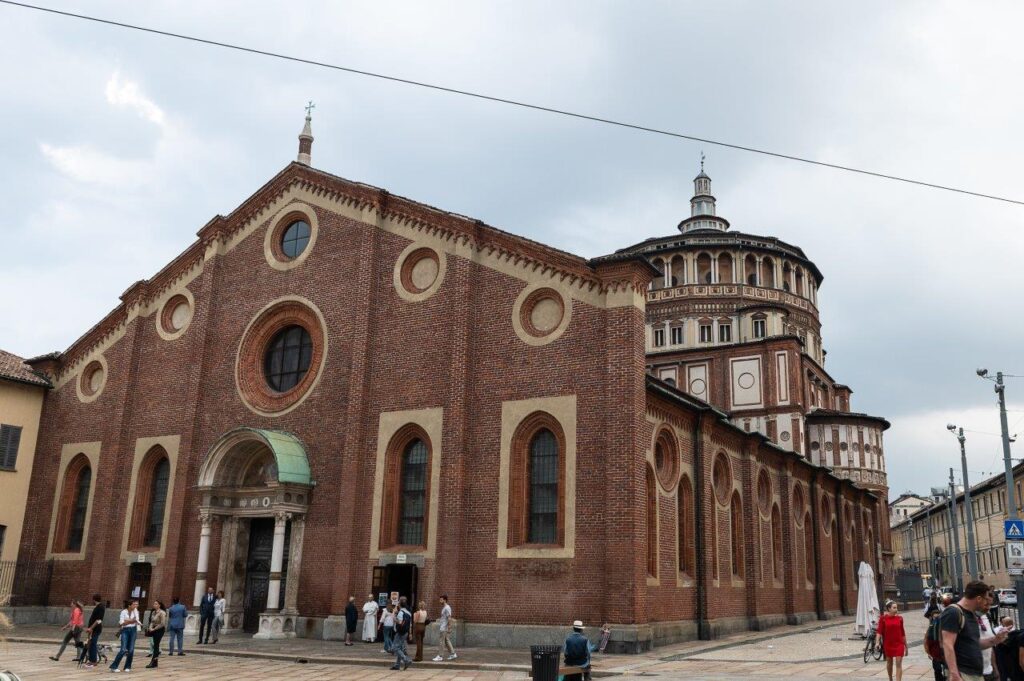
Shortly after the Supper’s completion, the inevitable happened. In 1499, a fortress commander betrayed Ludovico Il Moro, and the French invaded Lombardy and occupied Milan. Belligerent Ludovico fled, and so loyal Leonardo saw no alternative but to leave the city as well. He went on to eventually produce the only painting to ever surpass in fame Il Cenacolo, the Mona Lisa, and in his life time still he became the unparalleled master painter of his generation and of those to follow. His military inventions however were only realized in 2004 by a team of scientists. Turned out, that none of them worked.
PART TWO: THE FIRST SUPPER
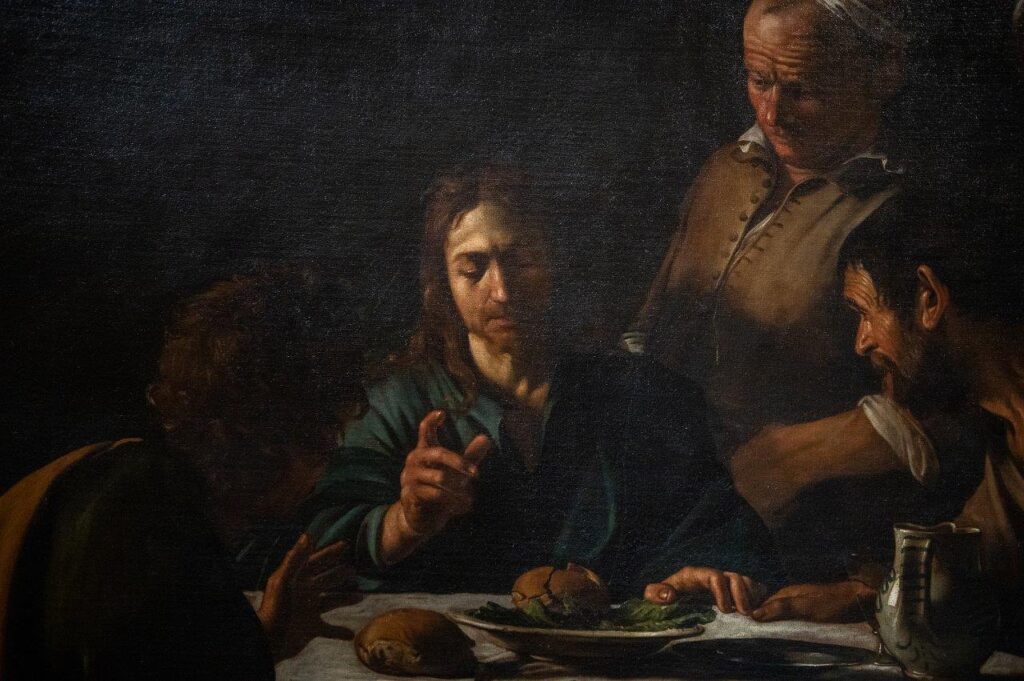
At 35, two years passed the age Jesus Christ resurrected from the dead, Michelangelo Merisi di Caravaggio was a dead man walking. Convicted to death for murder, on the run and in hiding, he started a new painting. The motive was the biblical account of Jesus revealing himself after his resurrection. Caravaggio executed the strokes rapidly, with feverish immediacy, painting a picture with a dramatic chiaroscuro effect, yet meditative intimacy which displayed the painful awareness of his own transience. Supper At Emmaus was to become his masterpiece.
Caravaggio, the most important painter of Baroque, was the proverbial enfant terrible. Really he was a child of his time, and above all, a child of Milan.
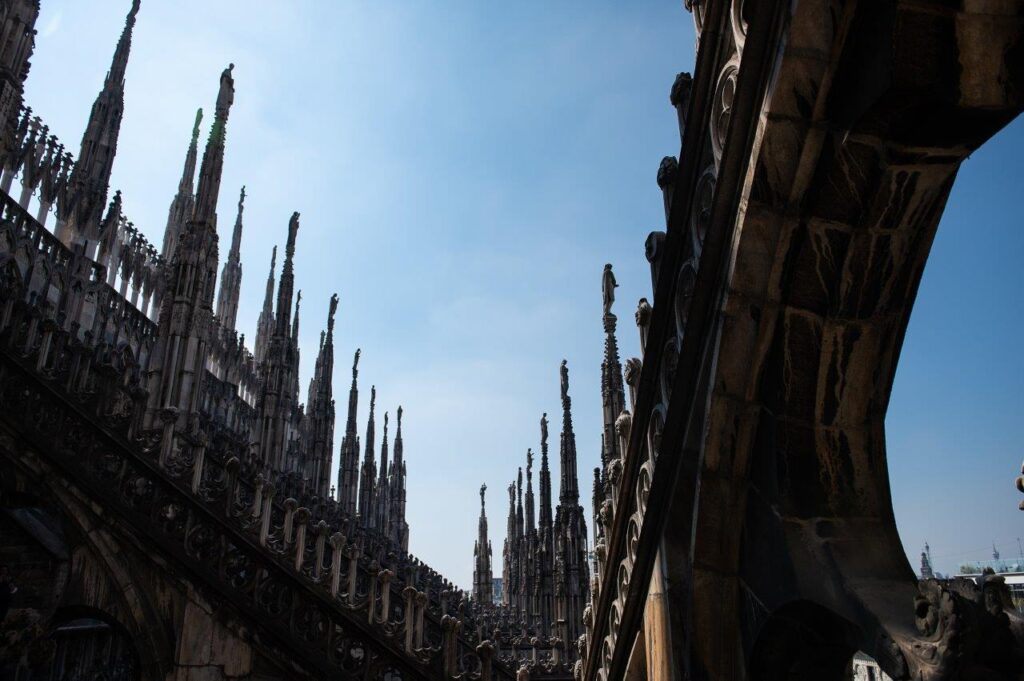
Michele Meritzi was born in September 1571 into a Milan that had dramatically changed since the days of Ludovico Il More. By the middle of the 16th century, the city had fallen under Spanish rule. The strictly catholic Habsburgers were a lacklustre house, and the new austere archbishop of Milan, Carlo Borromeo, cast a dark shadow over the city.
Carlo Borromeo had been the mastermind of the Council of Trent, which kicked off the catholic counter-reformation. A tall, ascetic man of aquiline features, yet highly educated and charismatic, Borromeo had been appointed archbishop of Milan by his uncle, Pope Pious, at the age of only twenty-two on the grounds of his ardent Catholicism and fanatic devotion to Jesus and the eradication of all heresy. Together with the Habsburg court, who looked to quell social dissent in the population, he implied a mixture of aggressive jurisdictional, religious, and quasi sanitary policies called the Milanese Inquisition. Its Ecclesiastical Court had its seat at the Dominican monastery Maria Delle Grazie in the buildings by the refectory, and the friars that dined with Jesus in the midst were now his inquisitors.
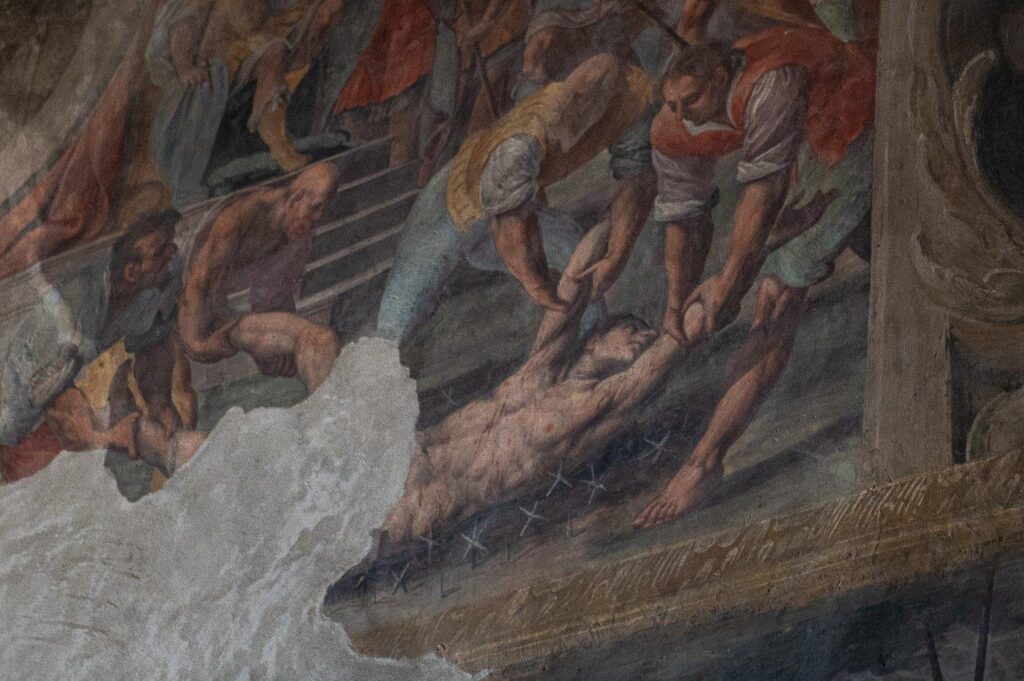
In 1576, the plague hit Milan again The Meritzi family, like anyone else who could afford it, fled the city. Michele’s mother, the young Lucia, was of noble descent, and so with her family she moved into her family’s rural estates in Caravaggio 80kms to the east of Milan. In vain. The Plague caught up with them and little Michele’s father, grandfather and uncle passed away.
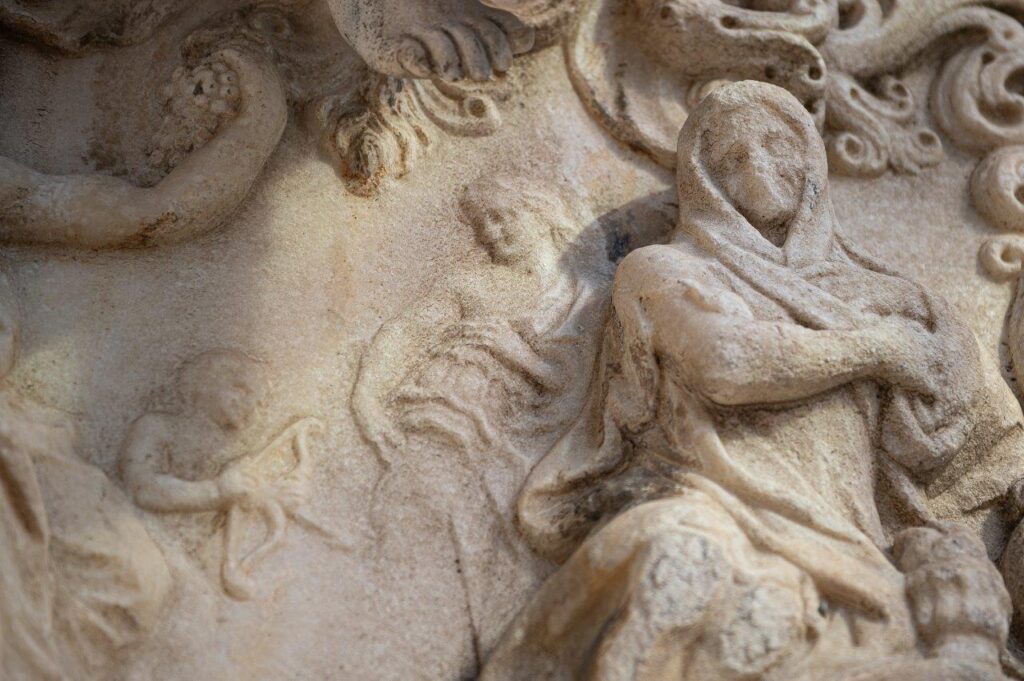
In the city of Milan, the plague ravaged for two years and ripped away a quarter of the population. But it was Borromeo’s finest hour. He spent his personal property to feed the poor and tend to the sick, yet he also he blamed the Plague on the lassitude of the previous years. Heresy was the plague, and the plague a heresy. And so, to fortify the spirituality of the community, he set up flagellant processions through the city in which he walked barefooted with a noose around his neck, intonating polyphone psalms and hymns in a call-response pattern to enable the illiterate laymen to join in the prayers. As sanitary rules had locked the population into their homes, the harmonious choir was an invisible one, and plague stricken Milan was turned into a ghostly Via Crucis. By the end of the plague that cost the 20,000 Milanese lives, Archbishop Borromeo had established himself as the patron saint of the poor. He was beatified in 1610. His tomb where his mummified body still lies, is in the Duomo, the world’s third biggest church.
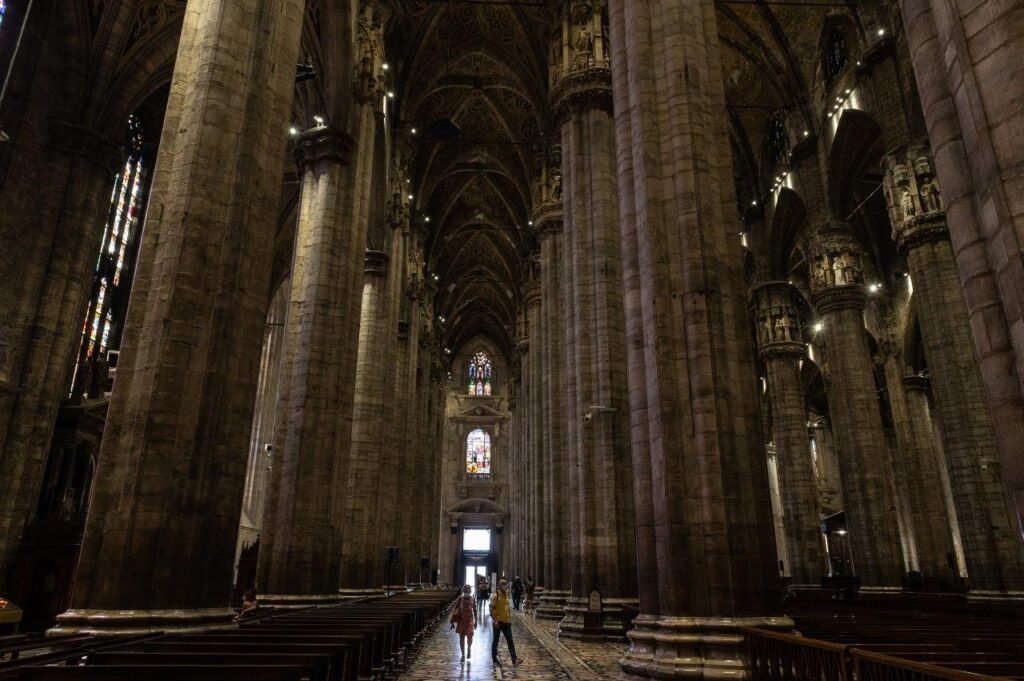
Meanwhile Michele grew up in the foggy flat land of the Po Valley, where society had remained deeply feudal and oppressive. The Lombards were of a matter-of-factly mentality, a language simple and plain, an art that was naturalistic and realistic, devoid of embellishments and pretentiousness. But with a strong tradition of painting.
Lombard painters excelled in depicting nature – animals, birds and flowers – a long tradition that had benefitted from Leonardo da Vinci’s long stay in the city, from his sfumato and chiaroscuro, his handling of perspective and proportion, the moti mentali, the inner motions.
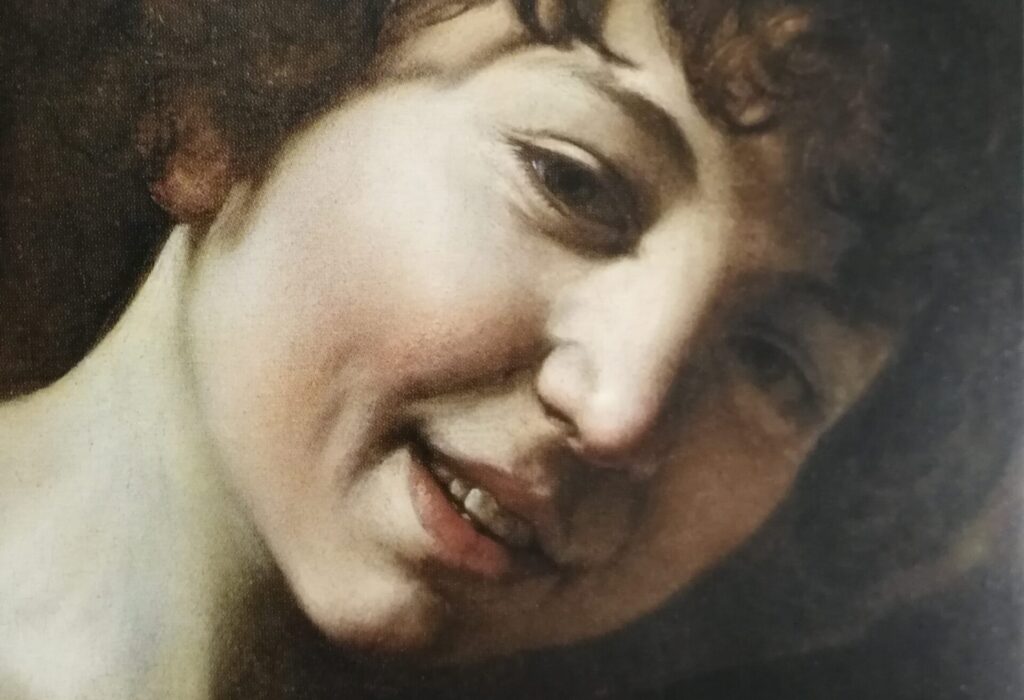
Caravaggio studied with the local painters, but he never kept a notebook. There is no evidence of any doodles or sketches, nor a diary. It will never be known what attracted him to painting, or Lombard art, to which we was exposed in Caravaggio’s impressive cathedral. But maybe the answer is the all-engulfing white fog that lay on the marshes of the Po-Valley, and on the endless rice fields. In the creeping whiteness that robbed the world the clear-cut shapes and colours, maybe the half orphaned boy looked for contour, for something to grasp and hold on to. Maybe to him art was truer than reality.
At thirteen, Michele was an angry teenager with uncontrollable temperamental outbursts. His mother sent him back to the city to apprentice in Simone Peterzano’s workshop.
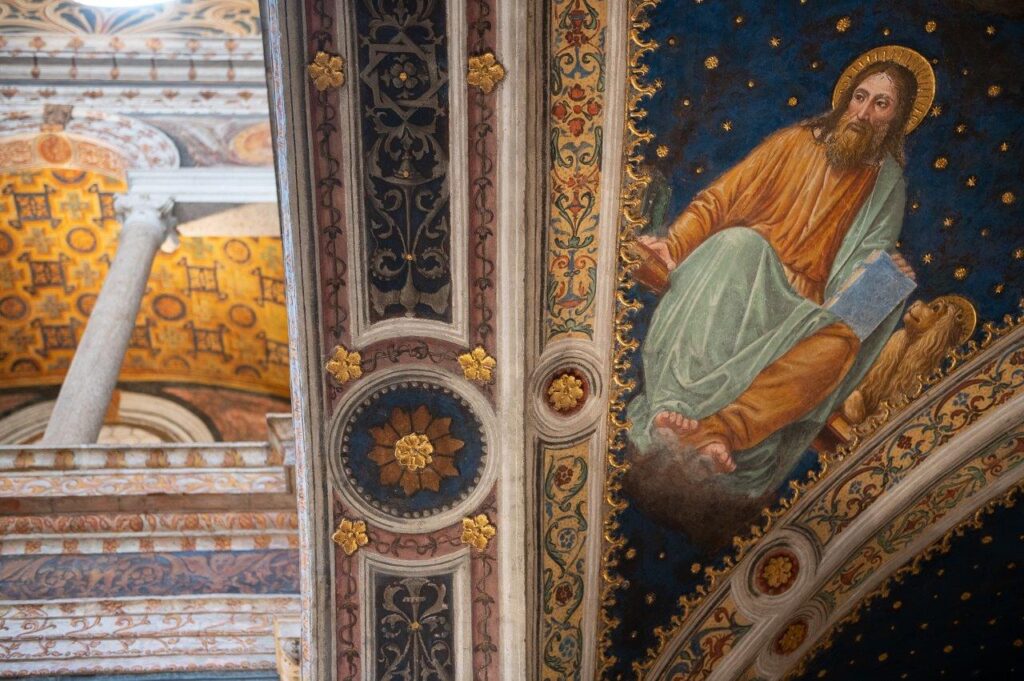
Simone Peterzano was known for his precise naturalism and subtle eroticism, in a more mannerist Renassaince style. Two of his frescoes can still be seen in the recently renovated and colourfully bubbly church San Maurizio al Monastero Maggiore, a Benedict convent not far from Maria Delle Grazie.
Maybe Peterzano influenced Michele to change his name to Michelangelo Merisi. Other than that, little is known about Merisi’s apprenticeship in Milan. Given his temperament, it’s improbable that he remained four years with Peterzano or even studied much with him. It is more likely disappeared days on end in the bustling backstreets of Milan. There is no doubt, though, that when Caravaggio left Milan for Rome, at the age of seventeen, he was an accomplished Lombard painter, his style characterized by a sober naturalism that valued realism more than beauty, and an accomplished man of the sword.
He was never to return.
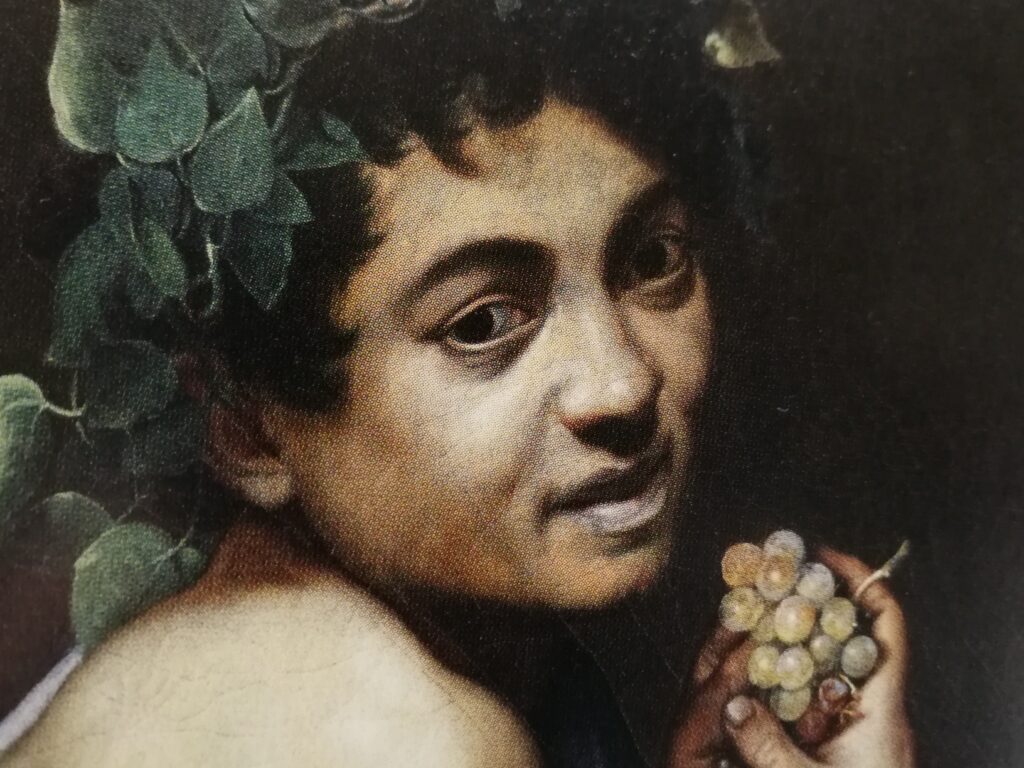
Merisi, like many artists from all across the peninsula had flocked to Rome on invitation of the Vatican, to compose the peans, create the statues, and construct the buildings to resurrect faith in angels and demons, in saints and the Virgin Mary, and most of all, the pope. And to instil fear. It was Carlo Borromeo himself who had created the Baroque playbook that called for drama, for blood, for pain and pleasure, and the physical joys of spiritual rapture.
Merisi’s paintings were outstanding in Rome. Other painters venerated him for his unique naturalism, his clients for the inner motions of the characters, and their not so subtle (homo-) erotic qualities. One of his first clients was Federico Borromeo, who would follow his uncle as archbishop of Milan. In 1596 he bought “Basket of fruit”, a still life. Never before had he seen a painting, the new archbishop claimed, with more inner life. And there wasn’t even a person in the frame. The painting shows a stray basket overburdened with ripe fruit: figs and grapes, pears and apples, their leaves wildly intertwining. But the apples and pears are worm-eaten, soon they will rot. The leaves are shrivelling and withering. This is not only an eerily realistic rendering of a fruit basket, it is the sober depiction of the irreversibility time passing. The painting is now exhibited in the Pinacoteca Ambrosiana in Milan.
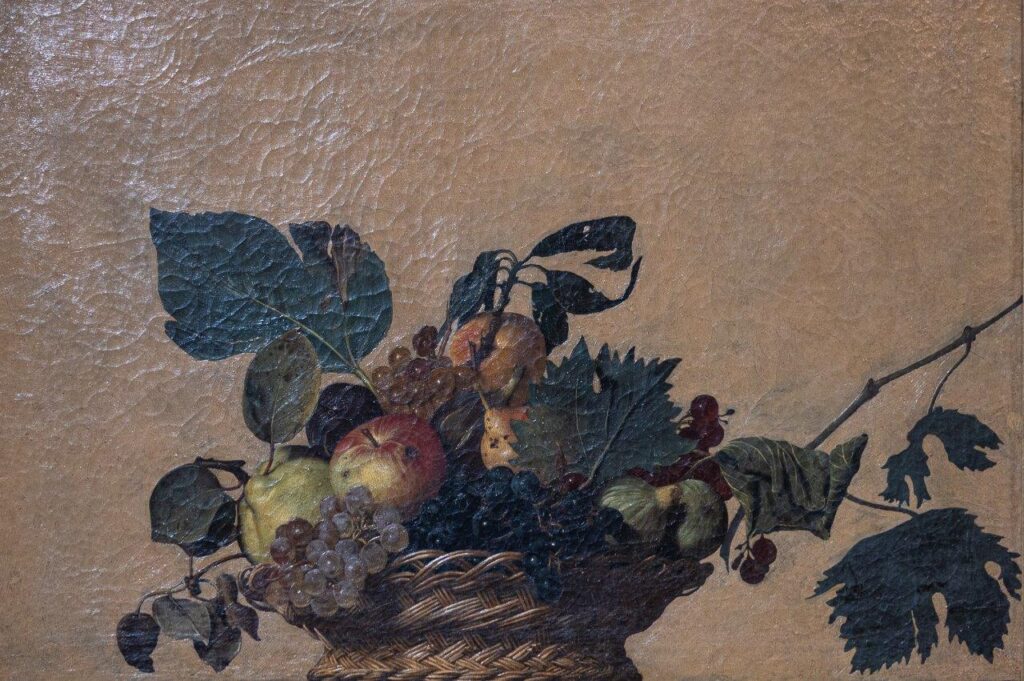
Soon Merisi became the superstar of the Roman art scene, the darling of the wealthy and mighty: a highly attractive, charismatic young man who indulged in scandalous love affairs. But although he worked for the cardinals, and lived and dined in their palaces, his temperament pulled him back to the streets. He took up his old life, frequenting gloomy taverns, engaging in quarrels and street fights, joined a gang and carried a dagger. Then he dropped his name, and called himself Caravaggio.
Caravaggio painted in fervour and heated rush, finishing paintings within a few days, delivering them still wet. His models were the people of the streets, his saints and the Virgin Mary’s wore ragged clothes, had calloused feet and black rimmed toe nails. By the age of thirty three, the age Jesus died on the cross, Caravaggio had painted the entire crucifixions, beheadings, and flagellations of the Old and the New Testament, depicting the sordid details and inner motions of pleasure and pain. The cardinals were enraptured.
In 1606, the inevitable happened. Caravaggio killed a man.
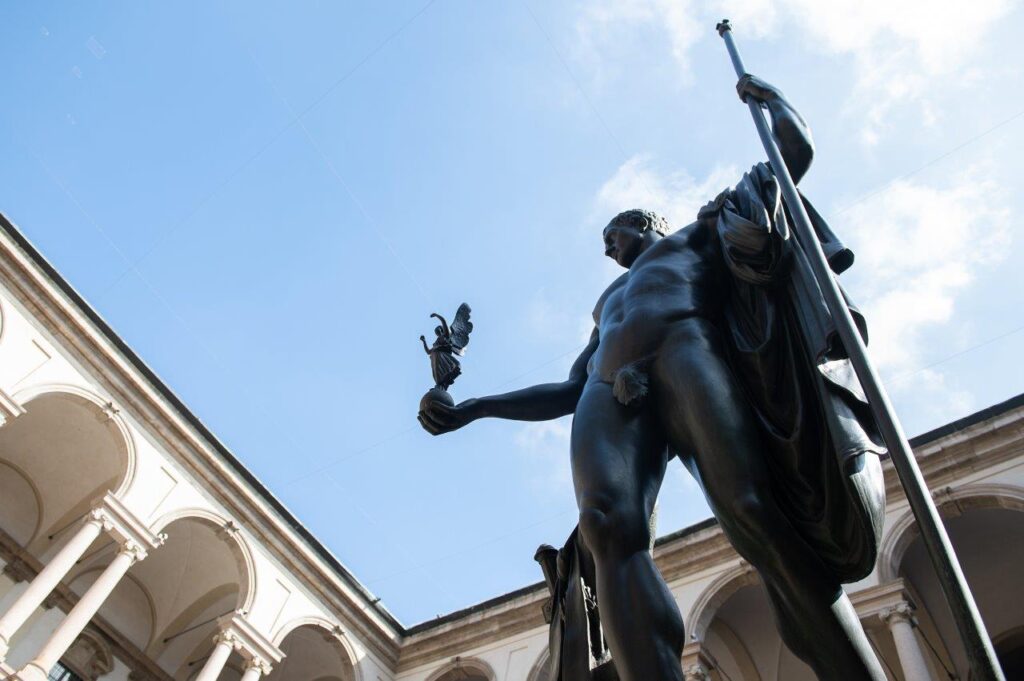
The setting of Supper in Emmaus is contemporary. A group of four is seated around a table in a gloomy tavern, dressed in Italian clothes. The light falls from above on Jesus face, the only one in frontal view, and on a plate of salad in front of him. There are white bread rolls scattered on the table. It’s a poor man’s food. The four other characters that surround him are portrayed in profile, semi profile or from the back, their faces are directed towards Jesus. Their gestures express disbelief, wonder, hope, and worry. Again, Jesus is among the poor, among the sinners, he reveals himself where least one will expect him.
Caravaggio painted the picture in repentance, hoping for deliverance, and amnesty. In vain. Caravaggio died on the run and was forgotten by the world for a long time.
His genius and importance were only re-discovered in 1910. Now Supper at Emmaus is considered one of the masterpieces of baroque. A present day visitor to Milan can see the painting at the Pinacoteca the Brera, a twenty minute walk from the Maria Delle Grazie, where the Leonardo’s Last Supper is still open to the public.
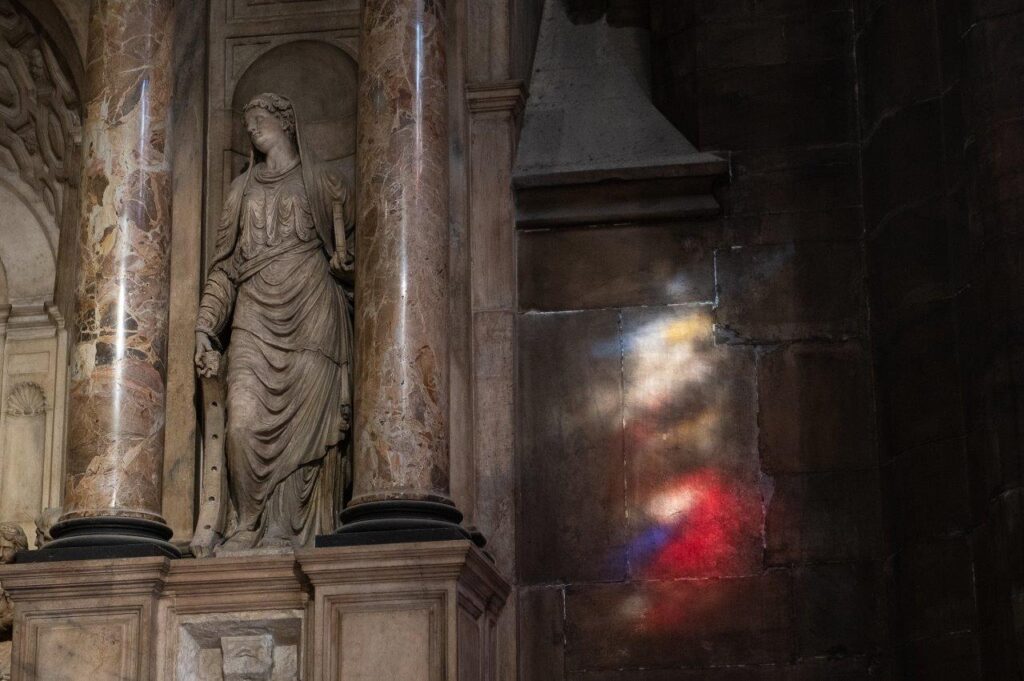
Epilogue:
During the first wave of the Corona pandemic, in Spring 2020, Milan and the Lombardy were among the places hit the hardest. The city was locked down, strongly enforced restrictions turned the once bubbling city into a Ghost town. Pictures of coffins, of medics in plastic suits, news of triage and oxygen shortness went across the world. And the songs of an invisible harmonious choir, the people of Milan intonating the folksongs from their windows and balconies.
By 2021, Milan has recovered, and is one of the first places of Europe to resume pre-pandemic life, the scala is open again, the restaurants are serving dinner. There will always be a first supper, after the last.
